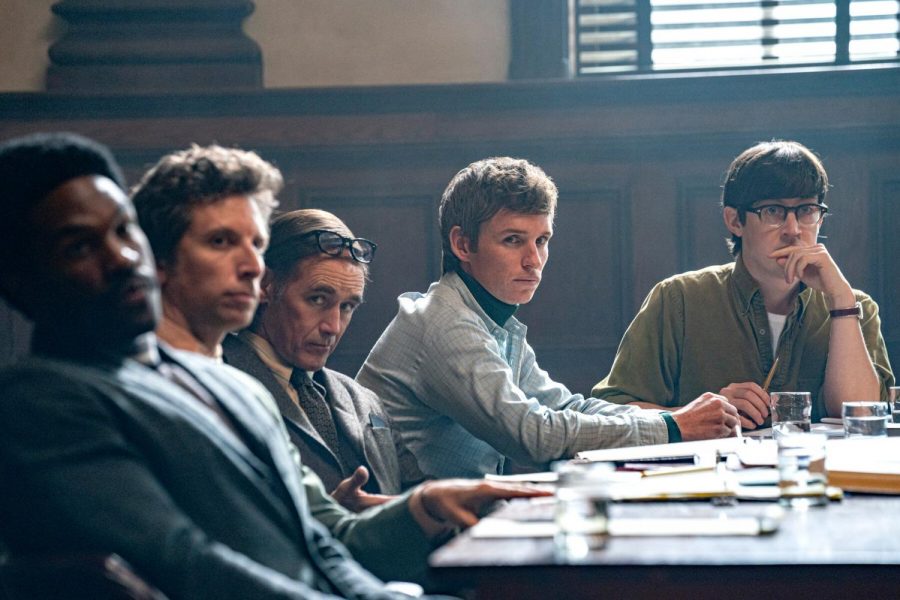Your donation will support the student journalists of The Tide, Richard Montgomery High School's student newspaper. Your contribution will allow us to purchase equipment and cover our annual website hosting costs.
‘The Trial of the Chicago 7’ stuns audiences with a powerful depiction of political protest
December 9, 2020
“The Trial of the Chicago 7,” released in theaters on Sept. 25, 2020, coincides with the surge of political unrest and protest beginning in June of this year.
Warning for viewers: this film contains depictions of violence and assault reflecting historical anti-Vietnam War protests. Please read and watch at your own discretion.
“The Trial of the Chicago 7” was released in theaters on Sept. 25, 2020, just in time to coincide with the surge of political unrest and protest beginning in June of this year. Written and directed by Aaron Sorkin, the movie is an adaptation of real historical events: the protest against the Vietnam War that took place in Chicago at the 1968 National Democratic Convention and the following trial in 1969. It addresses violence and protests within our democracy in a powerful way.
The movie sets up the event with the eight figures centered around the protest, defining each one’s character and motives in a rapid but clear way. It builds up to the protest at the convention through short clips, showing what each expects in different ways. It outlines how even though they come together with different reasons and perspectives, they are united in their determination to fight for justice and the end of the war. The characters feel real and are fairly accurate to history, making it all the more interesting to watch. The principal characters all had strong motivation for their own beliefs, and I wanted to support and see the characters succeed.
The story follows history with a decent amount of accuracy as well, with some rearrangement of timing and dramatization of events. It shows the harshness of protests and the fight for equality, with very little censorship. The scenes tend to show the brutality of the clash between police and protesters, emphasizing it to make the events more dramatic yet still showing the true severity of the protest. The dialogue and scenes are fluid, and I enjoyed how natural they felt.
The protest scenes feel powerful and accurate, and the chaos and spontaneity of the moment make it engaging and captivating. Many of the court scenes feel true and realistic, not boring but also not overdramatized. The defendants’ frustration and pain are expertly conveyed, and as the viewer, I was able to empathize and feel their struggle. However, I thought parts of the movie were unrealistic. The ending in particular deviates from reality, turning in a more picture-perfect inspirational direction. While it is not accurate, I enjoyed this as a conclusion and thought it fit the nature of the defendants, continuing to follow their beliefs even when they knew the inevitable result.
I thought that while the story and portrayal were notable work on the part of the actors and writing, the technical direction of the movie was also powerful and enhancing. The story seamlessly ties the scenes in court and the present to the protest itself. Despite jumping back in time so often, it was easy to tell between the present and the past.
The constant shifts between scenes strike a balance between the energy-filled and action-packed protest and the serenity and quiet of the court. The way the accounts of the event line up portray the danger of the protest and its effects with the retrospective feelings—regret, pride, anger, frustration, desperation. The use of lighting and framing was also incredibly powerful. The same standard is used for each scene in court, bringing a sense of stability and calm. On the opposite end, the protest is told through a mixture of chaotic, varying footage and black-and-white video, drawing my eye and presenting memorable imagery.
Regardless of the historical accuracy, the story is powerful and underscores several important themes. The unity of the seven men, despite their constantly mentioned differences and disagreements, shows the importance of coming together. They are aware of their morals and the impact their actions have, telling us about the power of just a few people when they are able to garner the attention of many.
The theme of fighting for equality in the public spotlight is illustrated by a story that takes place in 1969, but the theme retains significance. It has a hard impact and while some may not like the violence and cruelty, the film shows a truth of history that is important for people to know. It manages to be educational yet entertaining, devastating yet inspiring, intricate yet powerful, revealing new layers of and perspectives on equality.
